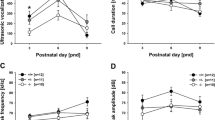Abstract
Rationale: Young rodents emit ultrasonic vocalizations (USVs) when separated from their dams and littermates. Pharmacological agents that act on GABAA and/or 5-HT receptors and that alleviate anxiety in humans reduce the emission of these calls. Objectives: 1) to investigate specific 5-HT1 receptor subtypes that modulate maternal separation-induced USVs in mice; 2) to assess the behavioral specificity of these effects; and 3) to compare 5-HT1 agonists with a positive neurosteroid modulator of the GABAA receptor complex. Methods: Seven-day old CFW mouse pups were isolated from their littermates and placed onto a 20°C surface for 4 min. USVs between 30 and 80 kHz, grid crossing, and rectal temperature were measured in separate groups of mouse pups following subcutaneous administration of 5-HT1A and 5-HT1B receptor agonists and antagonists, the neurosteroid allopregnanolone, or the benzodiazepine midazolam. Results: The 5-HT1A agonists (+)8-OH-DPAT (0.01–0.1 mg/kg) and flesinoxan (0.3–1.0 mg/kg), the selective 5-HT1B agonist CP-94,253 (0.03–30.0 mg/kg), and the mixed 5-HT1B/2C receptor agonist TFMPP (0.1–10.0 mg/kg) dose-dependently reduced USVs. These effects were reversed by the 5-HT1A receptor antagonist WAY 100,635 (0.1 mg/kg) or the 5-HT1B/D receptor antagonist GR 127935 (0.1 mg/kg). The effects of TFMPP were biphasic; low doses (i.e. 0.01 and 0.03 mg/kg) increased the rate of vocalization. Midazolam and allopregnanolone also reduced USVs. The highest doses of flesinoxan, (+)8-OH-DPAT, and allopregnanolone suppressed locomotion, whereas CP-94,253, TFMPP, and midazolam stimulated motor activity. Conclusions: These experiments confirm that agonists at the 5-HT1 receptors and a positive allosteric modulator of the GABAA receptor complex decrease maternal separation-induced USVs in mice, with 5-HT1B manipulations dissociating the effects on vocalizations from sedative effects.
Similar content being viewed by others
Author information
Authors and Affiliations
Additional information
Received: 22 September 1999 / Final version: 14 December 1999
Rights and permissions
About this article
Cite this article
Fish, E., Sekinda, M., Ferrari, P. et al. Distress vocalizations in maternally separated mouse pups: modulation via 5-HT1A, 5-HT1B and GABAA receptors. Psychopharmacology 149, 277–285 (2000). https://doi.org/10.1007/s002130000370
Issue Date:
DOI: https://doi.org/10.1007/s002130000370




